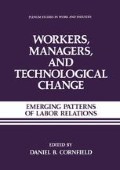Abstract
The newspaper industry provides an ideal context for studying the impact of industrial and technological change on the labor process. Sociologists have long noted the exemplary craftsmanship and occupational pride of the printing trades.1 These authors viewed printing as “an anachronism in the age of large scale industrial organization,”2 where the venerable traditions of craftsmanship, pride in one’s work, and control over the immediate work process remained virtually undaunted by technological change. Yet recent advances in automating nearly all phases of newspaper production have rendered obsolete Blauner’s original portrait of the printing craftsman. Indeed, it is difficult to think of an industry where the transformations wrought by technological change have been so profound. Smith has recently remarked that the newspaper industry is “the dove sent from the ark of mechanical society to test the waters of computerization.”3 Surely, there are few other industries that, in the span of a single generation, so embody the remembrances of our preindustrial past and prefigure the future of an automated society.
Access this chapter
Tax calculation will be finalised at checkout
Purchases are for personal use only
Preview
Unable to display preview. Download preview PDF.
Reference
Seymour Martin Lipset, Martin Trow, and James Coleman, Union Democracy (New York: Free Press, 1956);
Robert Blauner, Alienation and Freedom (Chicago: University of Chicago Press, 1964).
Anthony Smith, Goodbye Gutenberg: The Newspaper Revolution of the 1980s (New York: Oxford University Press, 1980), pp. 236–237.
Randy Hodson, “Labor in the Monopoly, Competitive, and State Sectors of Production”Politics and Society 8 (1978), pp. 429–480.
Robert Max Jackson, The Formation of Craft Labor Markets (New York: Academic Press, 1984)
Arthur R. Porter, Jr., Job Property Rights: A Study of the Job Controls of the International Typographical Union (New York: King’s Crown, 1954).
A. H. Raskin, “A Reporter at Large: Part I, ‘Changes in the Balance of Power’; Part II, Intrigue at the Summit.”The New Yorker ,(22 January and 29 January 1979)
Michael Wallace and Arne L. Kalleberg, “Industrial Transformation and the Decline of Craft: The Decomposition of Skill in the Printing Industry, 1931–1978.”American Sociological Review 47 (June 1982), pp. 307–324
Arne L. Kalleberg, Michael Wallace, and Larry E. Raffelovich, “Accounting for Labor’s Share: Class and Income Distribution in the Printing Industry,”Industrial and Labor Relations Review 37 (April 1984), pp. 386–402.
James N. Dertouzos and Kenneth E. Thorpe, Newspaper Groups: Economies of Scale, Tax Laws, and Merger Incentives (Santa Monica, CA: Rand Corporation, 1982), p. 94.
Ben H. Bagdikian, “Newspaper Mergers: The Final Phase,”Columbia Journalism Review 15 (March/April 1977), pp. 17–22
Robert L. Bishop, “The Rush to Chain Ownership,”Columbia journalism Review 11 (November/December 1972), pp. 10–19.
Toby J. Mcintosh, “Why the Government Can’t Stop Press Mergers,”Columbia Journalism Review 16 (May/June 1977), pp. 48–50; Smith, p. 54.
Stephan R. Barnett, “Monopoly Games-Where Failures Win Big,”Columbia Journalism Review 19 (May/June 1980), pp. 40–47
Gail L. Barwis, “The Newspaper Preservation Act: A Retrospective Analysis,”Newspaper Research Journal 2 (February 1980), pp. 27–39.
Harry Kelber and Carl Schlesinger, Union Printers and Controlled Automation (New York: Free Press, 1967), p. 3.
Andrew Zimbalist, “Technology and the Labor Process in the Printing Industry,”in Case Studies in the Labor Process ,ed. Andrew Zimbalist (New York: Monthly Review Press, 1979), pp. 103–126.
Richard C. Edwards, Contested Terrain (New York: Basic, 1979), p. 112.
United States Bureau of Labor Statistics, The Impact of Technology on Labor in Five Industries.Bulletin 2137 (Washington, DC: U.S. Government Printing Office, 1982).
Theresa F. Rogers and Natalie S. Friedman, Printers Face Automation (Lexington, MA.: D. C.Heath & Co., 1980).
Alan Janesch, “Pagination: The Dream Machine is Real,”Presstime 3 (1981), pp.5–9.
Study results cited in James Warren, “Technological Changes Smooth at Newspapers, Study Finds,”Chicago Tribune (16 April 1985), pp. 1, 8.
United States Bureau of Labor Statistics, Outlook for Technology and Manpower in Printing and Publishing. Bulletin 1774. (Washington, DC: U.S. Government Printing Office, 1973).
Jerry W. Friedham, “Year 2000 Newspaper: Electronic Age in Print,”Presstime 3 (1981), p. 19.
Tom Walker,“Automation Knocks on the Mailroom Door,”Presstime 4 (June 1982), pp. 4–9.
Clark Newsom, “‘Buyouts’ of Printers May Have Peaked” Presstime 2 (1981), pp. 4–9.
Clark Newsom, “For Printers, Life Varies After Accepting Buyouts,”Presstime 4 (December 1982), pp. 32–35.
Michael Wallace, “Responding to Technological Change in the Newspaper Industry: A Comparison of the United States, Great Britain, and the Federal Republic of Germany,”Proceedings of the Thirty-Seventh Annual Meetings of the Industrial Relations Research Association ,(1985), pp. 325–332.
Gail L. Barwis, “The Changing Face of Labor in the Newspaper Industry”Newspaper Research Journal 2 (January 1981), pp. 49–57.
Ralph Kessler, “The Death Agony of the Typographical Union,”Union Democracy Review 46 (1985), p. 660
Donald Sabeth, “PD Printers, Mailers Vote Switch to Teamsters,”Cleveland Plain Dealer (5 December 1984), pp. 1E–2E.
Tony Griffin, “Technological Change and Craft Control in the Newspaper Industry: An International Comparison,”Cambridge Journal of Economics 8 (March 1984), pp. 41–61
John Gennard and Steve Dunn, “The Impact of New Technology on the Structure and Organisation of Craft Unions in the Printing Industry,”British Journal of Industrial Relations 21 (1983), pp. 17– 32.
Harry Braverman, Labor and Monopoly Capital (New York: Monthly Review Press, 1974).
David M.Gordon, Richard Edwards, and Michael Reich, Segmented Work, Divided Workers (Cambridge: Cambridge University Press, 1982).
Author information
Authors and Affiliations
Editor information
Editors and Affiliations
Rights and permissions
Copyright information
© 1987 Plenum Press, New York
About this chapter
Cite this chapter
Kalleberg, A.L., Wallace, M., Loscocco, K.A., Leicht, K.T., Ehm, HH. (1987). The Eclipse of Craft. In: Cornfield, D.B. (eds) Workers, Managers, and Technological Change. Plenum Studies in Work and Industry. Springer, Boston, MA. https://doi.org/10.1007/978-1-4613-1821-7_3
Download citation
DOI: https://doi.org/10.1007/978-1-4613-1821-7_3
Publisher Name: Springer, Boston, MA
Print ISBN: 978-1-4612-9018-6
Online ISBN: 978-1-4613-1821-7
eBook Packages: Springer Book Archive

